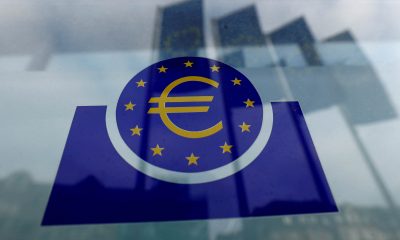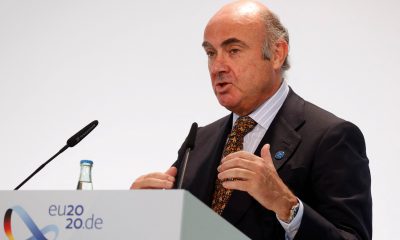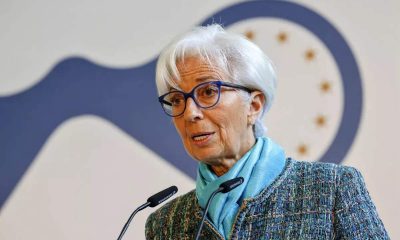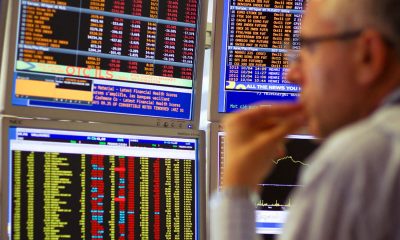Economy
Analysis: Germany leads big bond rally as inflation finally heads down

Germany is leading the biggest rally in global bond markets since March’s banking rout as cooling inflation and a weakening economy suggest European Central Bank rate hikes are nearing an end.
Borrowing costs, or bond yields, in the benchmark euro area issuer are down at least 20 basis points (bps) this week. Alongside British and U.S. peers, yields – which move inversely to bond prices – were set for their biggest weekly declines since mid-March when banking turmoil sparked a dash to safe-havens.
Certainly, government bonds remain hostage to data which one day might support the case for further rate increases and the next day suggest peak rates are near, keeping volatility high.
Yet this week’s notable moves suggest investors are plumping with the view that easing inflation and recession risks are strong bond buy signals.
Data from across the euro area, including Thursday’s bloc-wide print, showed inflation tumbling in May, throwing doubt on how much further rates need to rise.
Traders now expect the ECB hikes to peak at around 3.7% by September, suggesting two more hikes from 3.25% currently. A chance of 4% was priced in last week.
“We have argued that (the fall in) inflation (in the euro zone and in the UK) is lagging the U.S. … We think that is now changing,” said Kaspar Hense, senior portfolio manager at BlueBay Asset Management. “After summer, most likely the pressure on central banks (will be) much lower.”
The bond rally is being led by longer-dated yields, which are falling faster than shorter-dated ones in a so-called yield curve flattening that typically signals economic slowdown.
Signs were aplenty. Eurozone bank lending slowed again in April, a factory downturn deepened and economic sentiment in the bloc and Germany – which slipped into recession in early 2023 – deteriorated more than expected in May.
Flavio Carpenzano, investment director at Capital Group, which manages $2.2 trillion, said the firm was now more neutral on interest rate risk in the euro zone and positioning for a steepening of the yield curve – when shorter-dated borrowing costs fall faster than longer-dated ones – a bet it has made in the United States.
“The reason why is because we expect … recession to come in Europe (as well),” he said.
COMPLICATED
Investors cautioned that the European inflation outlook remained more complicated than in the United States, where inflation broadly is down sharply from peaks.
“It’s too early for the ECB to be happy about the dynamic on inflation,” said Cosimo Marasciulo, head of fixed income absolute return at Amundi, Europe’s largest asset manager overseeing $2.1 trillion.
“In terms of attractiveness of the market we think that U.S. rates, even more after this repricing, are more interesting from a medium-term point of view,” Marasciulo added.
He suspected the U.S. Federal Reserve was finished hiking rates and five-year Treasury yields would fall by up to 50 bps by the end of the year, from 3.8% now.
Britain’s Legal & General Investment Management is overweight U.S. Treasuries on recession expectations.
OUTLIER?
Britain is largely seen as an outlier. Its inflation, at 8.7%, is among the highest in Europe, suggesting UK government bonds, or gilts, will remain under pressure as traders bet sticky inflation will keep the Bank of England in rate-hiking mode longer than anticipated.
Two-year gilt yields jumped over 50 bps last week alone on higher than expected inflation numbers.
That has been a buy signal for some investors like BlueBay’s Hense, who has increased exposure to UK interest rate risk.
But NatWest Markets has revised up its 10-year gilt target to 4.6%, from 4.2% currently. Pictet Wealth Management has revised it year-end forecast to 4% from 3.3%.
Volatility – price swings in either direction – meanwhile looks likely to continue. A closely watched U.S. bond volatility gauge this week rose to its highest in almost two months. This week’s fall in borrowing costs followed sharp rises the previous two weeks on bets for more rate hikes..
Those bets too have swung wildly; as much as 75 bps of Fed rate cuts by year-end were priced in early May, but now expectations are for cuts of less than 20 bps.
Futures price a Fed pause in June, a sudden turnaround from solid bets for a 25 bps hike priced in last week.
Oliver Eichmann, head of rates, fixed income EMEA, at DWS, said he was cautious on shorter-dated bonds as central banks will need to remain vigilant on core inflation and won’t be able to lower rates once hikes end.
DWS expects the ECB to hike rates to 4%.
“It’s currently not that easy to navigate, because the point in time will come, and maybe it’s not that long in the distance, where you have to change your position from being cautious on the front end,” Eichmann said.
Economy
Russian central bank says it needs months to make sure CPI falling before rate cuts -RBC


© Reuters. Russian Central Bank Governor Elvira Nabiullina attends a news conference in Moscow, Russia June 14, 2019. REUTERS/Shamil Zhumatov/File Photo
MOSCOW (Reuters) – Russia’s central bank will need two to three months to make sure that inflation is steadily declining before taking any decision on interest rate cuts, the bank’s governor Elvira Nabiullina told RBC media on Sunday.
The central bank raised its key interest rate by 100 basis points to 16% earlier in December, hiking for the fifth consecutive meeting in response to stubborn inflation, and suggested that its tightening cycle was nearly over.
Nabiullina said it was not yet clear when exactly the regulator would start cutting rates, however.
“We really need to make sure that inflation is steadily decreasing, that these are not one-off factors that can affect the rate of price growth in a particular month,” she said.
Nabiullina said the bank was taking into account a wide range of indicators but primarily those that “characterize the stability of inflation”.
“This will take two or three months or more – it depends on how much the wide range of indicators that characterize sustainable inflation declines,” she said.
The bank will next convene to set its benchmark rate on Feb. 16.
The governor also said the bank should have started monetary policy tightening earlier than in July, when it embarked on the rate-hiking cycle.
Economy
China identifies second set of projects in $140 billion spending plan


© Reuters. FILE PHOTO: Workers walk past an under-construction area with completed office towers in the background, in Shenzhen’s Qianhai new district, Guangdong province, China August 25, 2023. REUTERS/David Kirton/File Photo
SHANGHAI (Reuters) – China’s top planning body said on Saturday it had identified a second batch of public investment projects, including flood control and disaster relief programmes, under a bond issuance and investment plan announced in October to boost the economy.
With the latest tranche, China has now earmarked more than 800 billion yuan of its 1 trillion yuan ($140 billion) in additional government bond issuance in the fourth quarter, as it focuses on fiscal steps to shore up the flagging economy.
The National Development and Reform Commission (NDRC) said in a statement on Saturday it had identified 9,600 projects with planned investment of more than 560 billion yuan.
China’s economy, the world’s second largest, is struggling to regain its footing post-COVID-19 as policymakers grapple with tepid consumer demand, weak exports, falling foreign investment and a deepening real estate crisis.
The 1 trillion yuan in additional bond issuance will widen China’s 2023 budget deficit ratio to around 3.8 percent from 3 percent, the state-run Xinhua news agency has said.
“Construction of the projects will improve China’s flood control system, emergency response mechanism and disaster relief capabilities, and better protect people’s lives and property, so it is very significant,” the NDRC said.
The agency said it will coordinate with other government bodies to make sure that funds are allocated speedily for investment and that high standards of quality are maintained in project construction.
($1 = 7.1315 renminbi)
Economy
Russian central bank says it needs months to make sure CPI falling before rate cuts -RBC


© Reuters. Russian Central Bank Governor Elvira Nabiullina attends a news conference in Moscow, Russia June 14, 2019. REUTERS/Shamil Zhumatov/File Photo
MOSCOW (Reuters) – Russia’s central bank will need two to three months to make sure that inflation is steadily declining before taking any decision on interest rate cuts, the bank’s governor Elvira Nabiullina told RBC media on Sunday.
The central bank raised its key interest rate by 100 basis points to 16% earlier in December, hiking for the fifth consecutive meeting in response to stubborn inflation, and suggested that its tightening cycle was nearly over.
Nabiullina said it was not yet clear when exactly the regulator would start cutting rates, however.
“We really need to make sure that inflation is steadily decreasing, that these are not one-off factors that can affect the rate of price growth in a particular month,” she said.
Nabiullina said the bank was taking into account a wide range of indicators but primarily those that “characterize the stability of inflation”.
“This will take two or three months or more – it depends on how much the wide range of indicators that characterize sustainable inflation declines,” she said.
The bank will next convene to set its benchmark rate on Feb. 16.
The governor also said the bank should have started monetary policy tightening earlier than in July, when it embarked on the rate-hiking cycle.

 Forex2 years ago
Forex2 years agoForex Today: the dollar is gaining strength amid gloomy sentiment at the start of the Fed’s week

 Forex2 years ago
Forex2 years agoHow is the Australian dollar doing today?

 Forex1 year ago
Forex1 year agoUnbiased review of Pocket Option broker

 Forex2 years ago
Forex2 years agoDollar to pound sterling exchange rate today: Pound plummeted to its lowest since 1985

 Cryptocurrency2 years ago
Cryptocurrency2 years agoWhat happened in the crypto market – current events today

 World2 years ago
World2 years agoWhy are modern video games an art form?

 Stock Markets2 years ago
Stock Markets2 years agoMorgan Stanley: bear market rally to continue

 Economy2 years ago
Economy2 years agoCrude oil tankers double in price due to EU anti-Russian sanctions

































